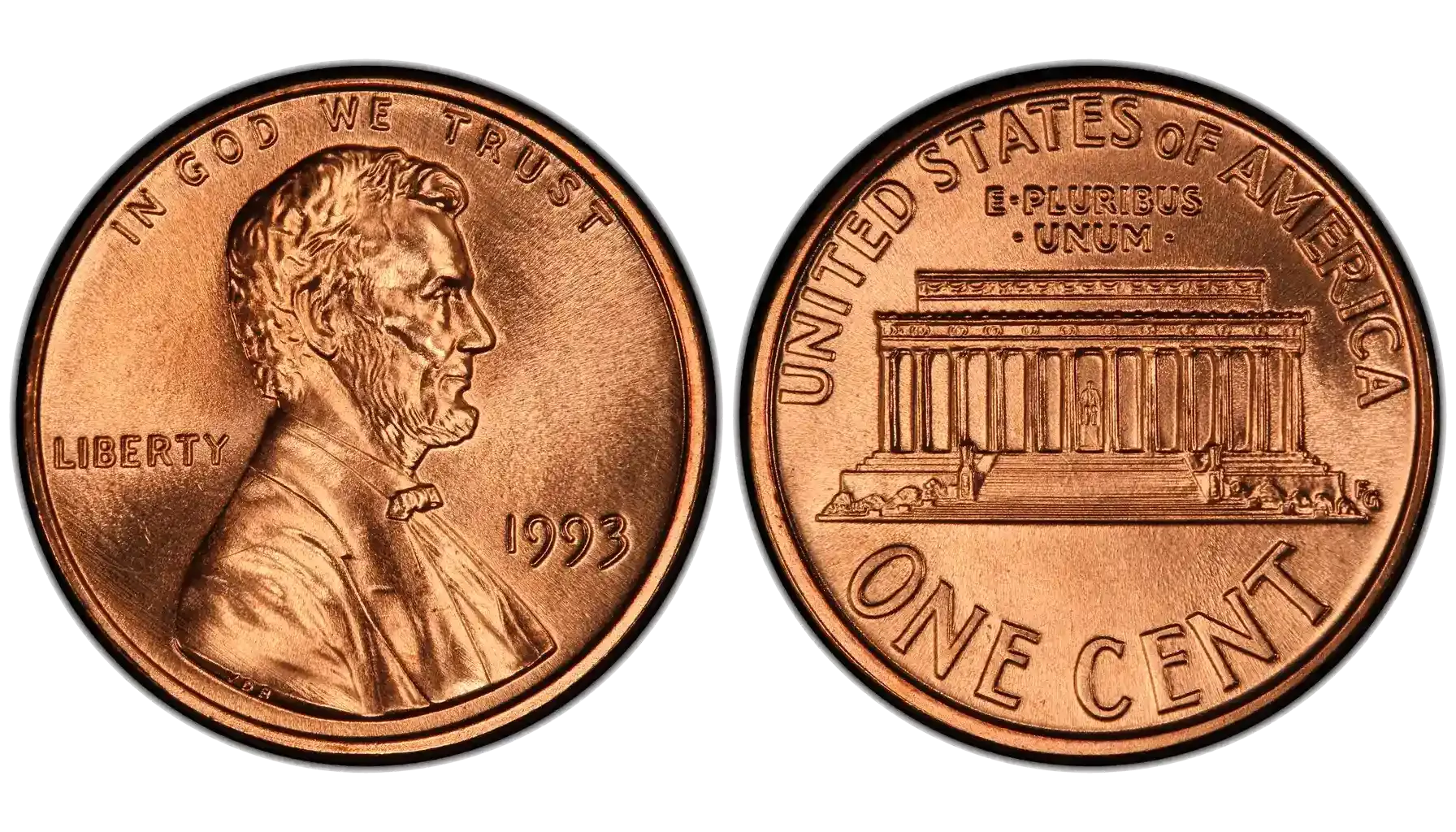Contents:
- A Look at the 1976 Roosevelt Coin Design
- Why No Bicentennial Design?
- Mintage Breakdown: How Common Is the 1976 Roosevelt Dime?
- Understanding What Is a 1976 Dime Worth
- Rare and Valuable Errors
- What Makes 1976 Dimes Worth Money?
- How to Manage Grading and Identify How Much Is a 1976 D Dime Worth
- Should You Keep, Grade, or Sell?
The year 1976 holds a special place in American history—it marked the Bicentennial of the United States, celebrating 200 years of independence. During this patriotic period, special commemorative designs were released for the quarter, half dollar, and dollar coins. Curiously, the 1976 Roosevelt dime was left untouched in terms of design, maintaining the same visuals it had since 1946. Still, the 1976 Roosevelt dime remains an object of interest for collectors and investors alike.
Even without a redesigned motif, the 1976 copper dime historical weight. It was minted during a milestone year, produced in huge quantities, and includes a handful of varieties and 1976 dime errors that raise its price beyond its modest face. In this guide, we’ll explore the design, production, and check value of coins that are often-overlooked.

A Look at the 1976 Roosevelt Coin Design
Despite being minted during the Bicentennial, the 1976 gold dime retained its original design—yet that’s part of what makes it intriguing. Unlike its flashier cousins of the year, this coin remained loyal to its roots.
Obverse (Front): Features a left-facing portrait of President Franklin D. Roosevelt. This design, created by John R. Sinnock, debuted in 1946, shortly after Roosevelt’s death. His profile is sharp and dignified, symbolizing his enduring influence on 20th-century America.
Reverse (Back): Displays a torch at the center flanked by an olive branch (peace) and an oak branch (strength), representing Roosevelt’s vision of unity, resilience, and democracy. The mottoes “E PLURIBUS UNUM” and “UNITED STATES OF AMERICA” encircle the emblematic imagery.
Edge: Reeded, which helps discourage shaving or clipping of the coin’s metal.
Composition: Not silver. The 1976 no mint dime is a cupronickel clad coin—composed of 91.67% copper and 8.33% nickel.
Here’s a quick glance at the coin’s specifications:
Specification | Detail |
Designer | John R. Sinnock |
Weight | 2.27 grams |
Diameter | 17.9 mm |
Edge | Reeded |
Composition | Copper-nickel (clad) |
Obverse Design | Franklin D. Roosevelt |
Reverse Design | Torch, olive & oak branches |
This consistency in design—even during the Bicentennial—makes the 1976 dime D mint mark unique in a different way. It serves as a benchmark for tradition amid widespread change.
Advised article: Learn how the iconic Roosevelt dime design has appeared.
Why No Bicentennial Design?
One of the first questions that numismatic newcomers ask is, “Why didn’t it get a Bicentennial redesign like the quarter, half dollar, or dollar?” The answer is simple—Congress authorized special reverse designs only for the three larger denominations to commemorate the Bicentennial. The dime, nickel, and penny were not included.
As a result, it is often mistakenly assumed to be a commemorative or special edition. While it is historically connected to the Bicentennial year, it’s not officially considered a “Bicentennial coin.” That said, this misconception has helped boost curiosity—and 1976 p dime value—around high-quality or misstruck specimens.
For history lovers: Here is a quick guide on presidents on US coins for your convenience.
Mintage Breakdown: How Common Is the 1976 Roosevelt Dime?
Now let’s look at how many of these coins were produced, and where:
Mint | Mint Mark | Mintage | Type |
Philadelphia | None | 568,760,000 | Circulation |
Denver | D | 695,222,774 | Circulation |
San Francisco | S | 4,149,730 | Proof (Collectors) |
These numbers confirm that the 1976 Roosevelt dime is not rare in the general sense. It was mass-produced, with well over a billion coins struck between the Philadelphia and Denver mints. However, San Francisco’s proof coins were minted in much smaller numbers and were never intended for general circulation—making them more desirable for numismatists who collect pristine specimens.
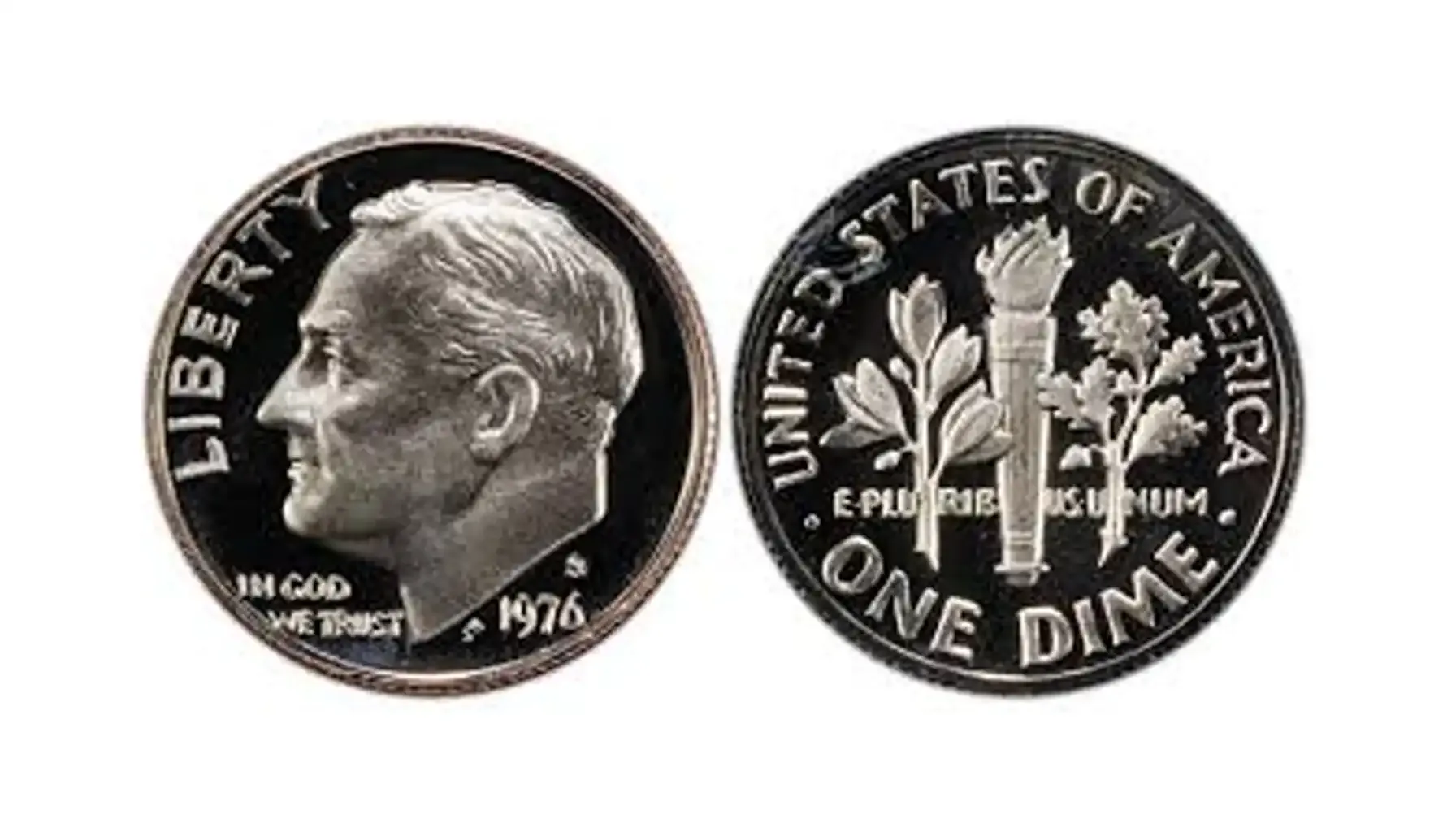
Understanding What Is a 1976 Dime Worth
At its face, the 1976 P Roosevelt dime is just 10 cents. However, collectors know that numismatics is rarely that simple. The true 1976 one dime coin value depends on multiple variables: mint mark, condition (grade), strike quality, and presence of rare mint errors. While most circulated 1976 dimes are common, some examples—especially high-grade uncirculated and error coins—have fetched hundreds or even thousands of dollars at auction.
Let’s break it down.
Face vs. Melt: Are 1976 Dimes Worth Anything
Face Dime 1976 Value: $0.10 (standard U.S. currency)
Melt Value: Also around $0.10, since the coin contains no silver and is made of base metals (copper and nickel).
Important: The 1976 Roosevelt dime contains no silver, unlike pre-1965 ones. This makes condition and rarity (not metal content) the key drivers of collector 1976 D dime value.
Collector 1976 S Dime Value by Grade & Mint
Coin grading uses the Sheldon Scale, ranging from Poor (P-1) to Perfect Mint State (MS-70). 1976 no mint mark dime value climbs dramatically as condition improves, especially with Full Bands (FB) on the reverse torch—an indicator of a strong strike.
Grade / Type | Philadelphia (No Mint Mark) | Denver (D) | San Francisco (S - Proof) |
Circulated | $0.10 | $0.10 | Not applicable |
Uncirculated (MS 65) | $6 | $5–$7 | — |
Uncirculated (MS 67) | Up to $200+ | Up to $37 | — |
Full Bands (FB MS 66/67) | $2,695 (MS 66, auction) | $1,700 (MS 67, auction) | — |
Proof (PR 69–70 DCAM) | — | — | $1,035 (PR 70 DCAM, auction) |
Full Bands (FB)
Coins with Full Bands on the torch are especially valuable. The horizontal lines across the torch must be fully separated and crisp to earn this designation. FB samples are more difficult to find in high grades and command significant premiums, especially at MS 66 and higher.
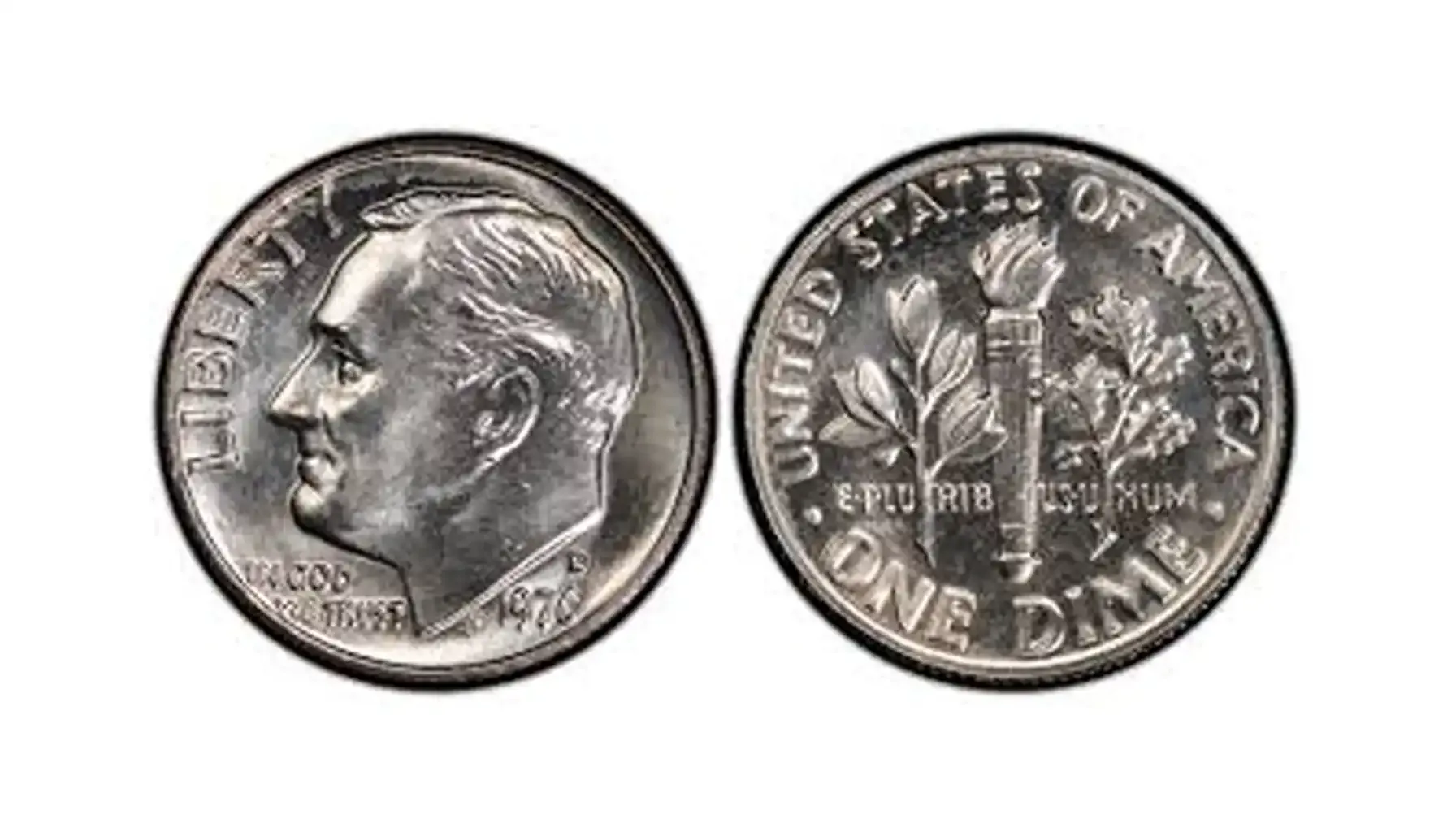
San Francisco Proofs
Proof coins minted in San Francisco (with an “S” mint mark) were never intended for general circulation. These coins are struck multiple times for a mirror-like finish and are often collected in sets. While many proof coins trade for modest sums, perfect PR70 DCAM examples can sell for over $1,000.
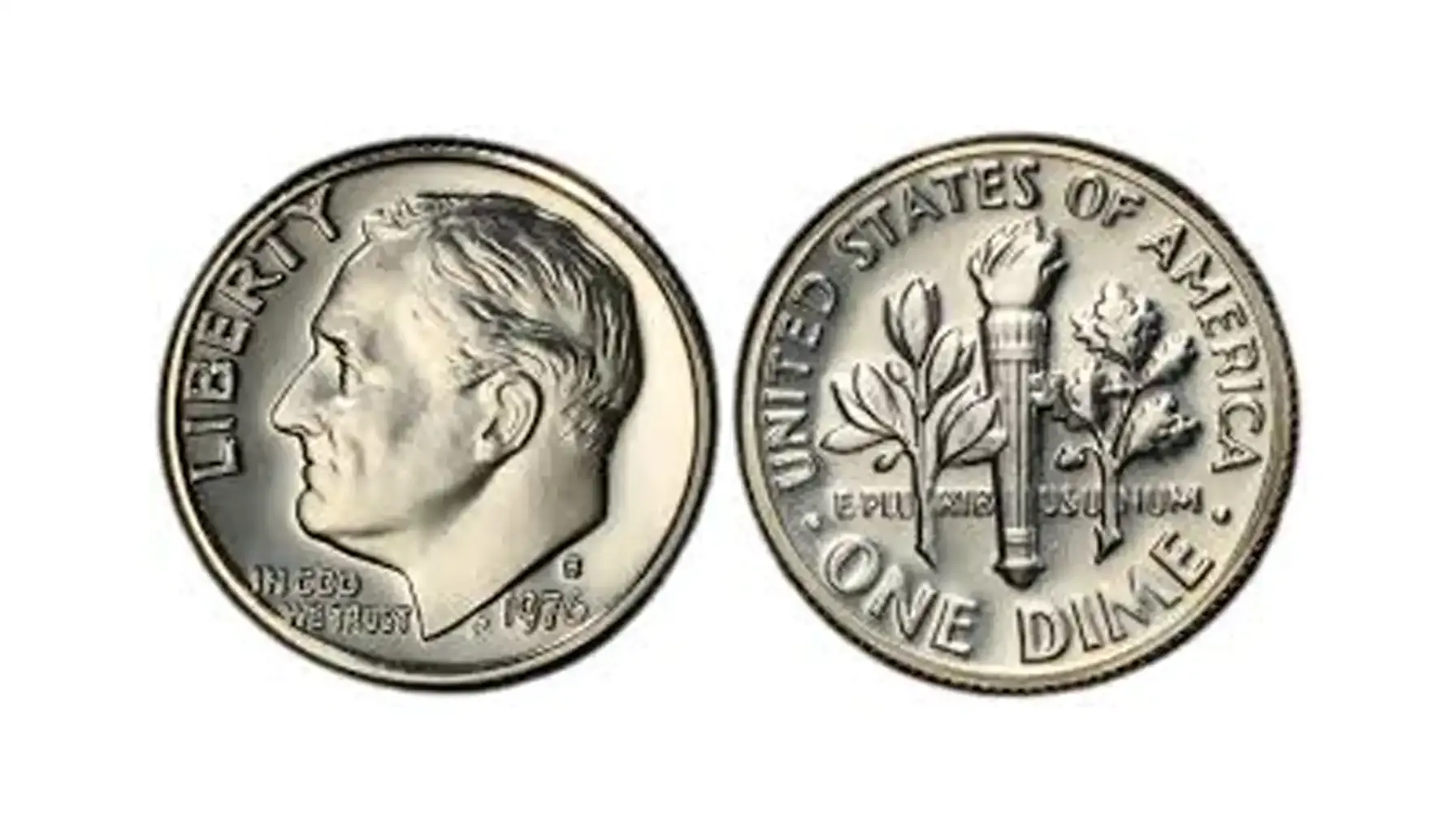
Rare and Valuable Errors
Error coins are another exciting aspect of rare 1976 dime collecting. These minting mishaps are often unintentional, but they can turn an ordinary coin into a valuable rarity. Here are some known and sought-after 1976 Roosevelt dime errors:
Error Type | Approximate Price Range | Description |
Blank Planchet | $10 | A coin struck without a design; just a blank metal disc. |
Clipped Planchet | $15–$50 | A coin with a curved or irregular edge due to a miscut blank. |
Missing Clad Layer | $5–$10 | One layer of the cupronickel coating is absent, exposing the copper core. |
Broad Strike | Up to $45 | Struck outside the collar, making the coin appear larger and flatter. |
Off-Center Strike | Up to $20 | The design is not properly centered, with a blank crescent on one side. |
While these errors are not always worth hundreds, they are appealing to niche collectors. Also, there are extremely rare cases like a double denomination 1976 bicentennial quarter struck on a dime, which are clearly seen and can be interesting to almost any collectionner. Combine an 1976 dime error in god we trust or another one with a high-grade strike, and the auction cost multiplies.
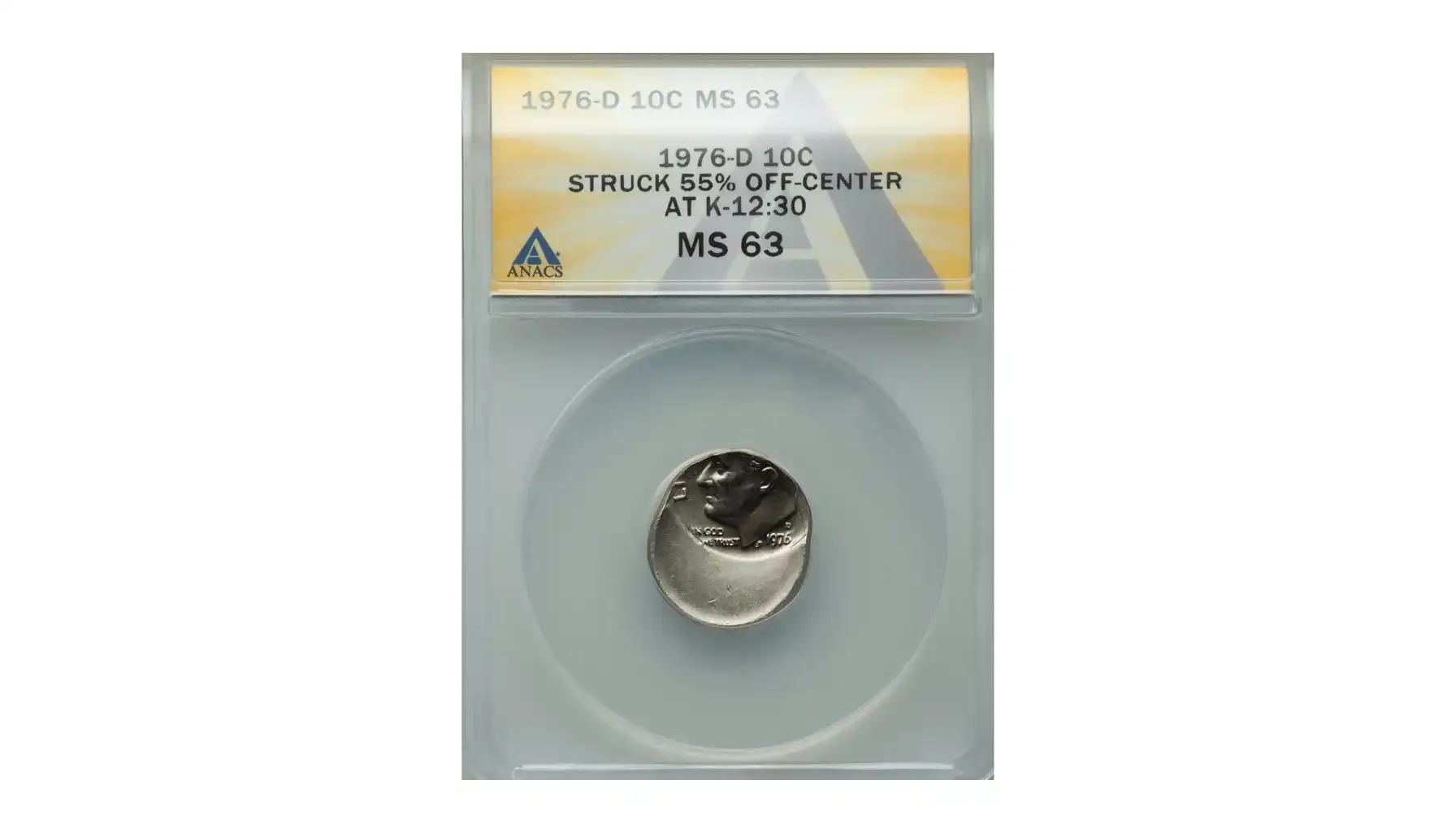
More info: Learn about dimes before the Roosevelt design, their importance and today’s value for collectors.
What Makes 1976 Dimes Worth Money?
Here’s a quick checklist to help you assess is a 1976 dime worth anything more than pocket change:
Is it uncirculated? Look for bright, original luster with no wear.
Does it have Full Bands? Check the torch on the reverse.
Does it have a 1976 dime no mint mark error? Look for irregularities, off-center strikes, or color changes. Also look through the 1976 dime error list with pictures for any similarities.
Is it a proof from San Francisco? Deep cameo contrast is most valuable.
Was it graded professionally (e.g., PCGS, NGC)? Third-party grading boosts buyer confidence.
How to Manage Grading and Identify How Much Is a 1976 D Dime Worth
Grading is one of the most critical steps in determining actual 1976 dime no mint mark value. The Sheldon grading scale (from 1 to 70) is the standard used by collectors and professional grading services alike. Here’s what to look for when examining your finding:
Circulated Coins (Grades P-1 to AU-58):
Dull surfaces and visible wear on Roosevelt’s hair, cheek, and jawline.
Torch details on the reverse may be flat or partially missing.
Typically worth its face only unless a 1976 d dime error value appears.
Mint State Coins (MS 60–70):
No wear from circulation.
Higher grades (MS 65+) feature full luster, sharp details, and minimal contact marks.
These are where the coin’s value can reach into the hundreds—especially with the Full Bands designation.
Full Bands (FB):
On the reverse torch, the horizontal bands should appear fully split and defined. This sharp strike is a sign of exceptional die condition and often results in a premium 1976 Canadian dime value.
Proof Coins (PR 60–70):
Made for collectors by the San Francisco Mint.
Look for Deep Cameo (DCAM) examples—high contrast between frosted design elements and mirror-like backgrounds.
The highest possible grade, PR70 DCAM, is flawless under magnification and can sell for $1,000+.
For visual reference, you can compare your coin to verified examples in Coin ID Scanner’s photo library or consult their detailed grading guides to evaluate key features like band sharpness, luster, and contact marks.
Should You Keep, Grade, or Sell?
If you’ve got a coin from the XX century, here’s a step-by-step decision tree. It will give you a quick answer to how much is a 1976 dime worth with no mint mark.
Is it circulated and worn?
Yes → Keep it as a historical piece or spend it.
No → Proceed to Step 2.
Is it uncirculated or proof with no visible wear?
Yes → Check for Full Bands or Deep Cameo.
No → Likely only worth a small premium.
Does it have an error (clipped planchet, off-center strike, etc.)?
Yes → Consider getting a professional appraisal or selling to error collectors. Also check the 1976 D dime error list with pictures before pro grading.
Do you suspect it’s high-grade (MS 66+ or PR70)?
Yes → Submit to a grading service like PCGS or NGC to confirm 1976 dime error value.
No → May still be worth a few dollars to hobbyists.
Looking to sell?
For top 1976 dime value no mint mark, sell through auction platforms like Heritage Auctions or Stack’s Bowers.
For convenience, consider trusted online marketplaces or local coin dealers.
For extra confidence, use an AI coin identifier to analyze your coins using high-resolution AI diagnostics. The app can identify potential FB details, proof contrasts, and detect common mint errors, saving you time and uncertainty.
Though it lacks a flashy commemorative design, the 1976 Roosevelt dime is far from ordinary. It’s a coin minted during a landmark year in American history, and it offers subtle but rewarding challenges for collectors—from spotting Full Bands to hunting for rare mint errors.

